Engine electrical MITSUBISHI LANCER 2005 Manual Online
[x] Cancel search | Manufacturer: MITSUBISHI, Model Year: 2005, Model line: LANCER, Model: MITSUBISHI LANCER 2005Pages: 788, PDF Size: 45.98 MB
Page 449 of 788
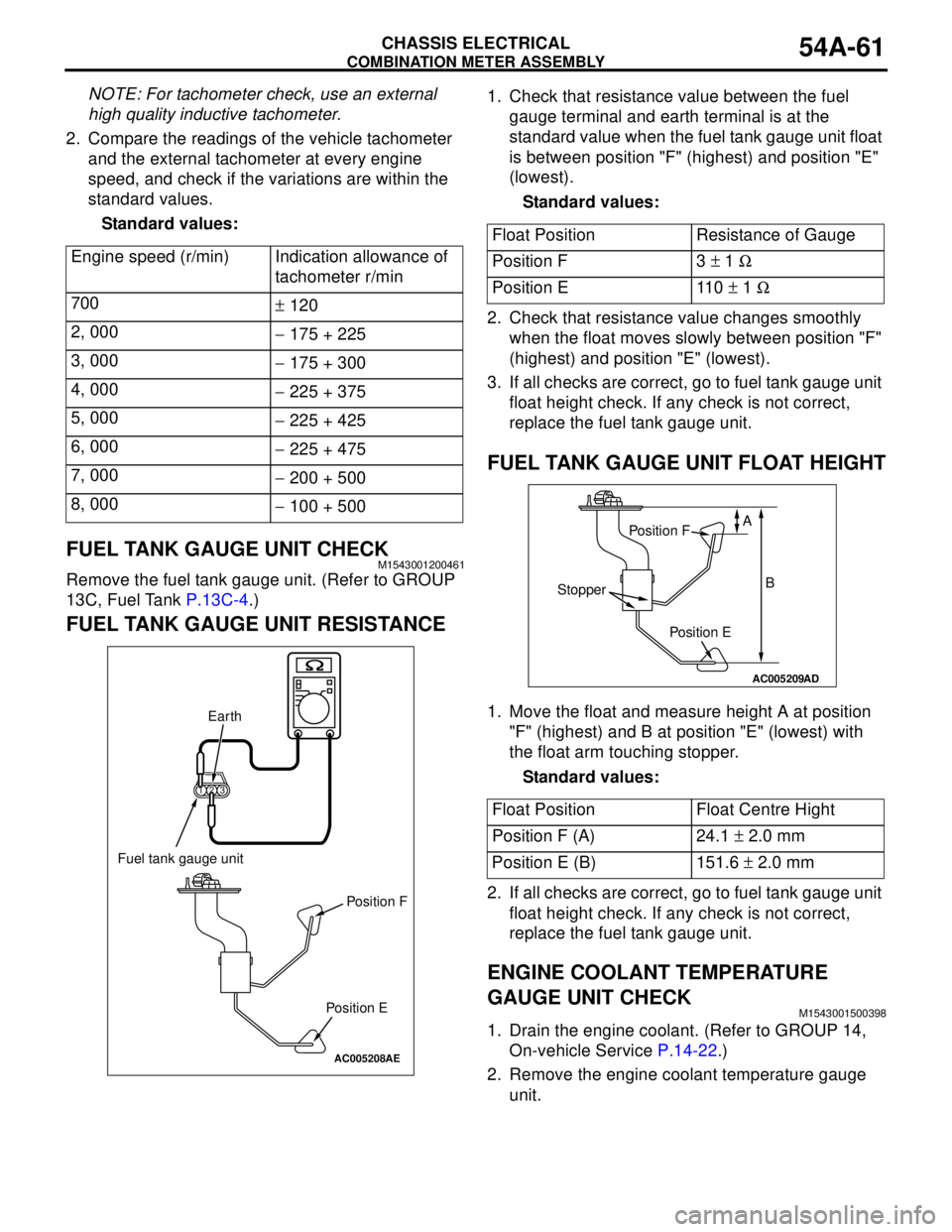
COMBINATION METER ASSEMBLY
CHASSIS ELECTRICAL54A-61
NOTE: For tachometer check, use an external
high quality inductive tachometer.
2. Compare the readings of the vehicle tachometer
and the external tachometer at every engine
speed, and check if the variations are within the
standard values.
Standard values:
FUEL TANK GAUGE UNIT CHECKM1543001200461
Remove the fuel tank gauge unit. (Refer to GROUP
13C, Fuel Tank P.13C-4.)
FUEL TANK GAUGE UNIT RESISTANCE
1. Check that resistance value between the fuel
gauge terminal and earth terminal is at the
standard value when the fuel tank gauge unit float
is between position "F" (highest) and position "E"
(lowest).
Standard values:
2. Check that resistance value changes smoothly
when the float moves slowly between position "F"
(highest) and position "E" (lowest).
3. If all checks are correct, go to fuel tank gauge unit
float height check. If any check is not correct,
replace the fuel tank gauge unit.
FUEL TANK GAUGE UNIT FLOAT HEIGHT
1. Move the float and measure height A at position
"F" (highest) and B at position "E" (lowest) with
the float arm touching stopper.
Standard values:
2. If all checks are correct, go to fuel tank gauge unit
float height check. If any check is not correct,
replace the fuel tank gauge unit.
ENGINE COOLANT TEMPERATURE
GAUGE UNIT CHECK
M1543001500398
1. Drain the engine coolant. (Refer to GROUP 14,
On-vehicle Service P.14-22.)
2. Remove the engine coolant temperature gauge
unit. Engine speed (r/min) Indication allowance of
tachometer r/min
700
± 120
2, 000
− 175 + 225
3, 000
− 175 + 300
4, 000
− 225 + 375
5, 000
− 225 + 425
6, 000
− 225 + 475
7, 000
− 200 + 500
8, 000
− 100 + 500
AC005208
123
AE
Fuel tank gauge unit
Earth
Position F
Position E
Float Position Resistance of Gauge
Position F 3 ± 1 Ω
Position E 110 ± 1 Ω
Float Position Float Centre Hight
Position F (A) 24.1 ± 2.0 mm
Position E (B) 151.6 ± 2.0 mm
AC005209
AD
Position F
Position E
Stopper
A
B
Page 450 of 788
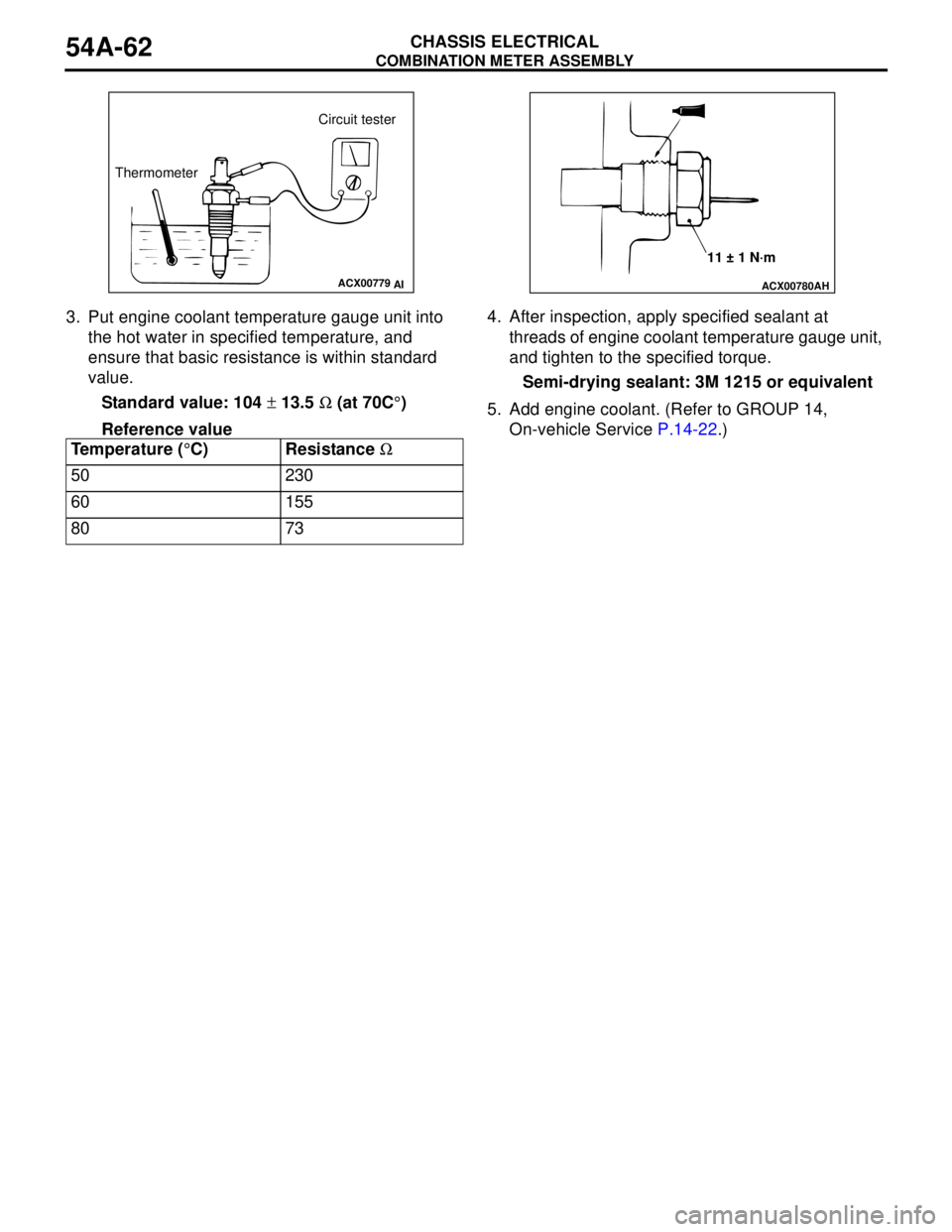
COMBINATION METER ASSEMBLY
CHASSIS ELECTRICAL54A-62
3. Put engine coolant temperature gauge unit into
the hot water in specified temperature, and
ensure that basic resistance is within standard
value.
Standard value: 104 ± 13.5 Ω (at 70C°)
Reference value4. After inspection, apply specified sealant at
threads of engine coolant temperature gauge unit,
and tighten to the specified torque.
Semi-drying sealant: 3M 1215 or equivalent
5. Add engine coolant. (Refer to GROUP 14,
On-vehicle Service P.14-22.)
Temperature (°C) Resistance Ω
50 230
60 155
80 73
ACX00779
AI
Circuit tester
Thermometer
ACX00780
AH
11 ± 1 N·m
Page 452 of 788
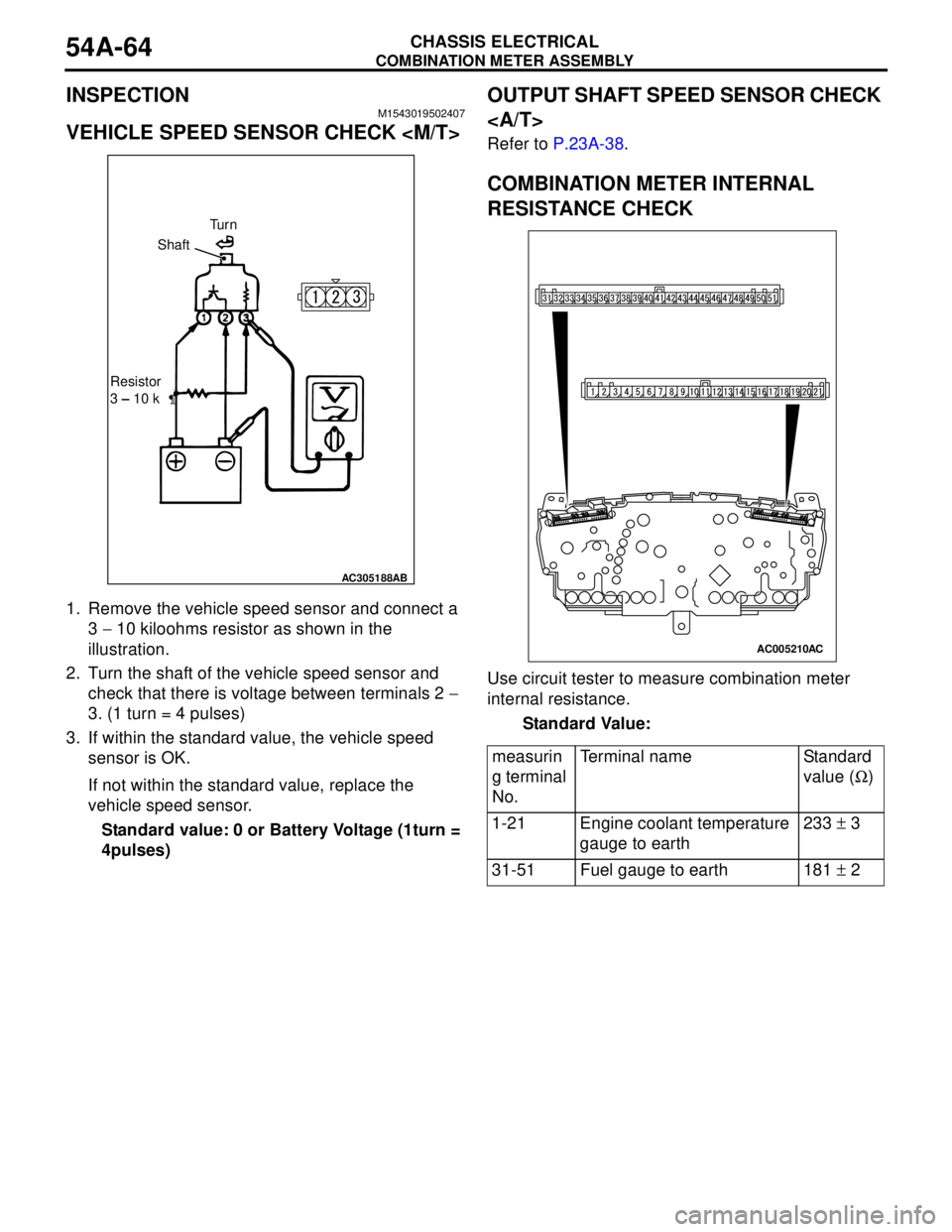
COMBINATION METER ASSEMBLY
CHASSIS ELECTRICAL54A-64
INSPECTIONM1543019502407
VEHICLE SPEED SENSOR CHECK
1. Remove the vehicle speed sensor and connect a
3 − 10 kiloohms resistor as shown in the
illustration.
2. Turn the shaft of the vehicle speed sensor and
check that there is voltage between terminals 2 −
3. (1 turn = 4 pulses)
3. If within the standard value, the vehicle speed
sensor is OK.
If not within the standard value, replace the
vehicle speed sensor.
Standard value: 0 or Battery Voltage (1turn =
4pulses)
OUTPUT SHAFT SPEED SENSOR CHECK
Refer to P.23A-38.
COMBINATION METER INTERNAL
RESISTANCE CHECK
Use circuit tester to measure combination meter
internal resistance.
Standard Value:
AC305188AB
Tu r n
Shaft
Resistor
3 – 10 k¶
measurin
g terminal
No.Terminal name Standard
value (Ω)
1-21 Engine coolant temperature
gauge to earth233 ± 3
31-51 Fuel gauge to earth 181 ± 2
AC005210AC
Page 455 of 788
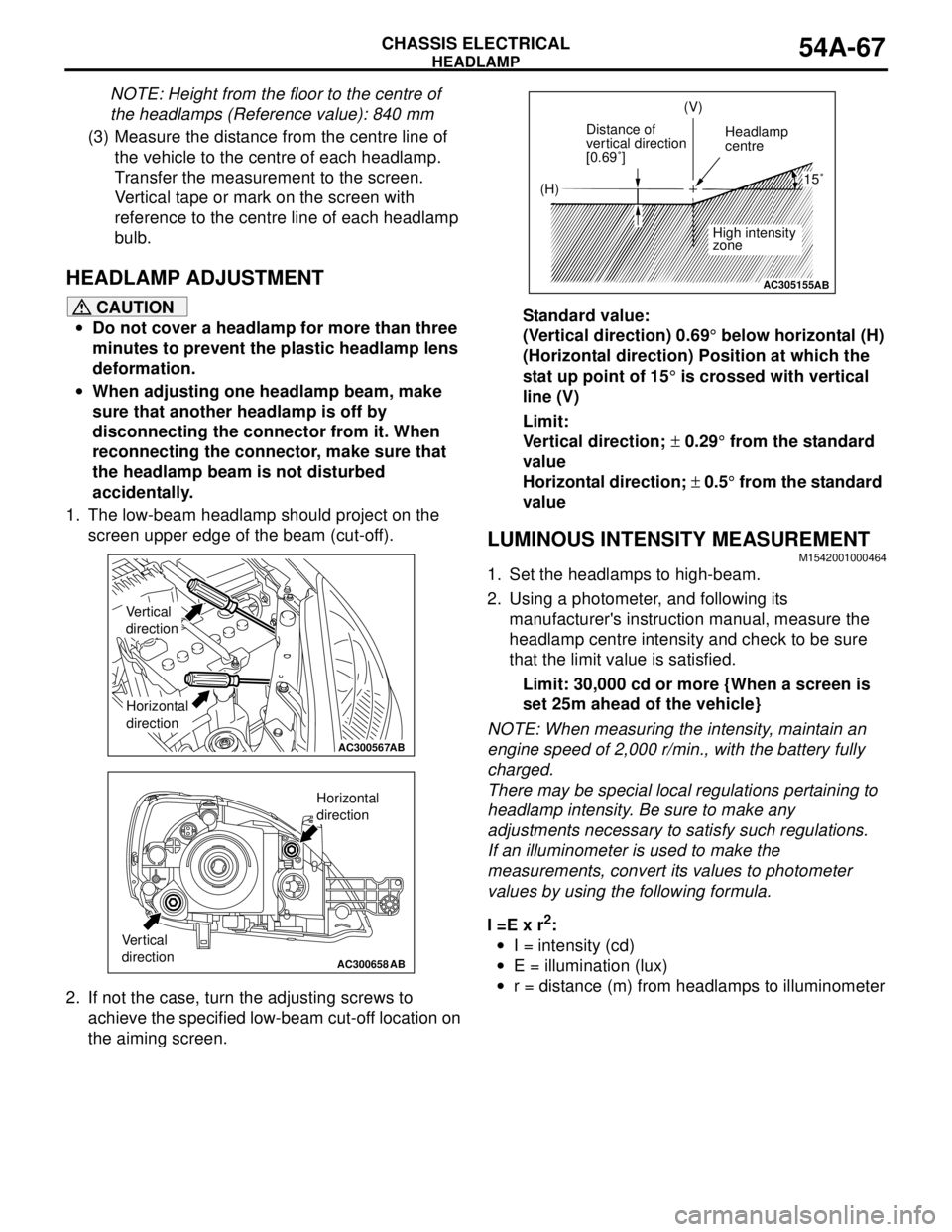
HEADLAMP
CHASSIS ELECTRICAL54A-67
NOTE: Height from the floor to the centre of
the headlamps (Reference value): 840 mm
(3) Measure the distance from the centre line of
the vehicle to the centre of each headlamp.
Transfer the measurement to the screen.
Vertical tape or mark on the screen with
reference to the centre line of each headlamp
bulb.
HEADLAMP ADJUSTMENT
CAUTION
•Do not cover a headlamp for more than three
minutes to prevent the plastic headlamp lens
deformation.
•When adjusting one headlamp beam, make
sure that another headlamp is off by
disconnecting the connector from it. When
reconnecting the connector, make sure that
the headlamp beam is not disturbed
accidentally.
1. The low-beam headlamp should project on the
screen upper edge of the beam (cut-off).
2. If not the case, turn the adjusting screws to
achieve the specified low-beam cut-off location on
the aiming screen.Standard value:
(Vertical direction) 0.69° below horizontal (H)
(Horizontal direction) Position at which the
stat up point of 15° is crossed with vertical
line (V)
Limit:
Vertical direction; ± 0.29° from the standard
value
Horizontal direction; ± 0.5° from the standard
value
LUMINOUS INTENSITY MEASUREMENTM1542001000464
1. Set the headlamps to high-beam.
2. Using a photometer, and following its
manufacturer's instruction manual, measure the
headlamp centre intensity and check to be sure
that the limit value is satisfied.
Limit: 30,000 cd or more {When a screen is
set 25m ahead of the vehicle}
NOTE: When measuring the intensity, maintain an
engine speed of 2,000 r/min., with the battery fully
charged.
There may be special local regulations pertaining to
headlamp intensity. Be sure to make any
adjustments necessary to satisfy such regulations.
If an illuminometer is used to make the
measurements, convert its values to photometer
values by using the following formula.
I =E x r
2:
•I = intensity (cd)
•E = illumination (lux)
•r = distance (m) from headlamps to illuminometer
AC300567AB
Vertical
direction
Horizontal
direction
AC300658AB
Vertical
direction
Horizontal
direction
AC305155
(H)(V)
Distance of
vertical direction
[0.69˚]Headlamp
centre
High intensity
zone
15˚
AB
Page 459 of 788
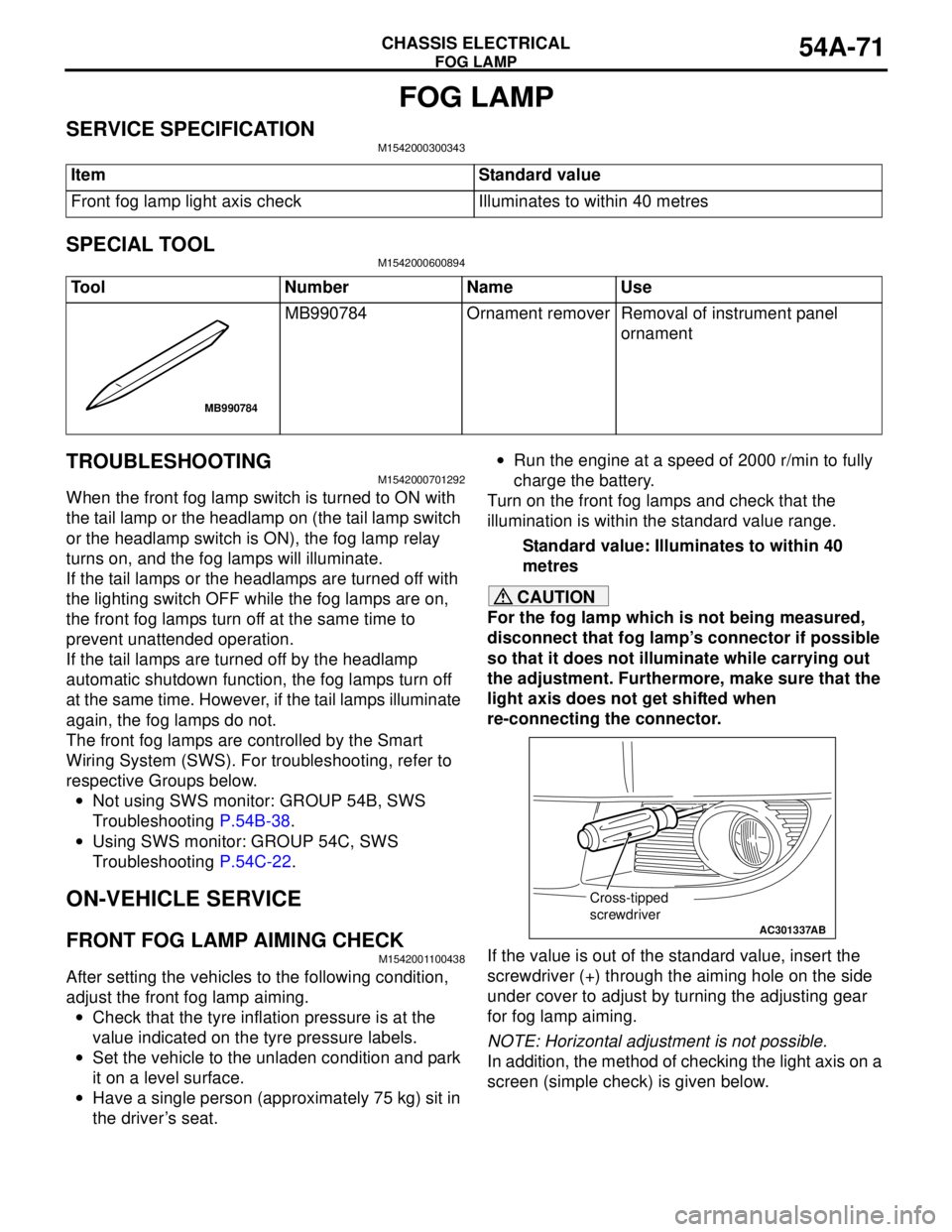
FOG LAMP
CHASSIS ELECTRICAL54A-71
FOG LAMP
SERVICE SPECIFICATIONM1542000300343
SPECIAL TOOLM1542000600894
TROUBLESHOOTINGM1542000701292
When the front fog lamp switch is turned to ON with
the tail lamp or the headlamp on (the tail lamp switch
or the headlamp switch is ON), the fog lamp relay
turns on, and the fog lamps will illuminate.
If the tail lamps or the headlamps are turned off with
the lighting switch OFF while the fog lamps are on,
the front fog lamps turn off at the same time to
prevent unattended operation.
If the tail lamps are turned off by the headlamp
automatic shutdown function, the fog lamps turn off
at the same time. However, if the tail lamps illuminate
again, the fog lamps do not.
The front fog lamps are controlled by the Smart
Wiring System (SWS). For troubleshooting, refer to
respective Groups below.
•Not using SWS monitor: GROUP 54B, SWS
Troubleshooting P.54B-38.
•Using SWS monitor: GROUP 54C, SWS
Troubleshooting P.54C-22.
ON-VEHICLE SERVICE
FRONT FOG LAMP AIMING CHECKM1542001100438
After setting the vehicles to the following condition,
adjust the front fog lamp aiming.
•Check that the tyre inflation pressure is at the
value indicated on the tyre pressure labels.
•Set the vehicle to the unladen condition and park
it on a level surface.
•Have a single person (approximately 75 kg) sit in
the driver’s seat.•Run the engine at a speed of 2000 r/min to fully
charge the battery.
Turn on the front fog lamps and check that the
illumination is within the standard value range.
Standard value: Illuminates to within 40
metres
CAUTION
For the fog lamp which is not being measured,
disconnect that fog lamp’s connector if possible
so that it does not illuminate while carrying out
the adjustment. Furthermore, make sure that the
light axis does not get shifted when
re-connecting the connector.
If the value is out of the standard value, insert the
screwdriver (+) through the aiming hole on the side
under cover to adjust by turning the adjusting gear
for fog lamp aiming.
NOTE: Horizontal adjustment is not possible.
In addition, the method of checking the light axis on a
screen (simple check) is given below. Item Standard value
Front fog lamp light axis check Illuminates to within 40 metres
Tool Number Name Use
MB990784 Ornament remover Removal of instrument panel
ornament
MB990784
AC301337
Cross-tipped
screwdriver
AB
Page 484 of 788
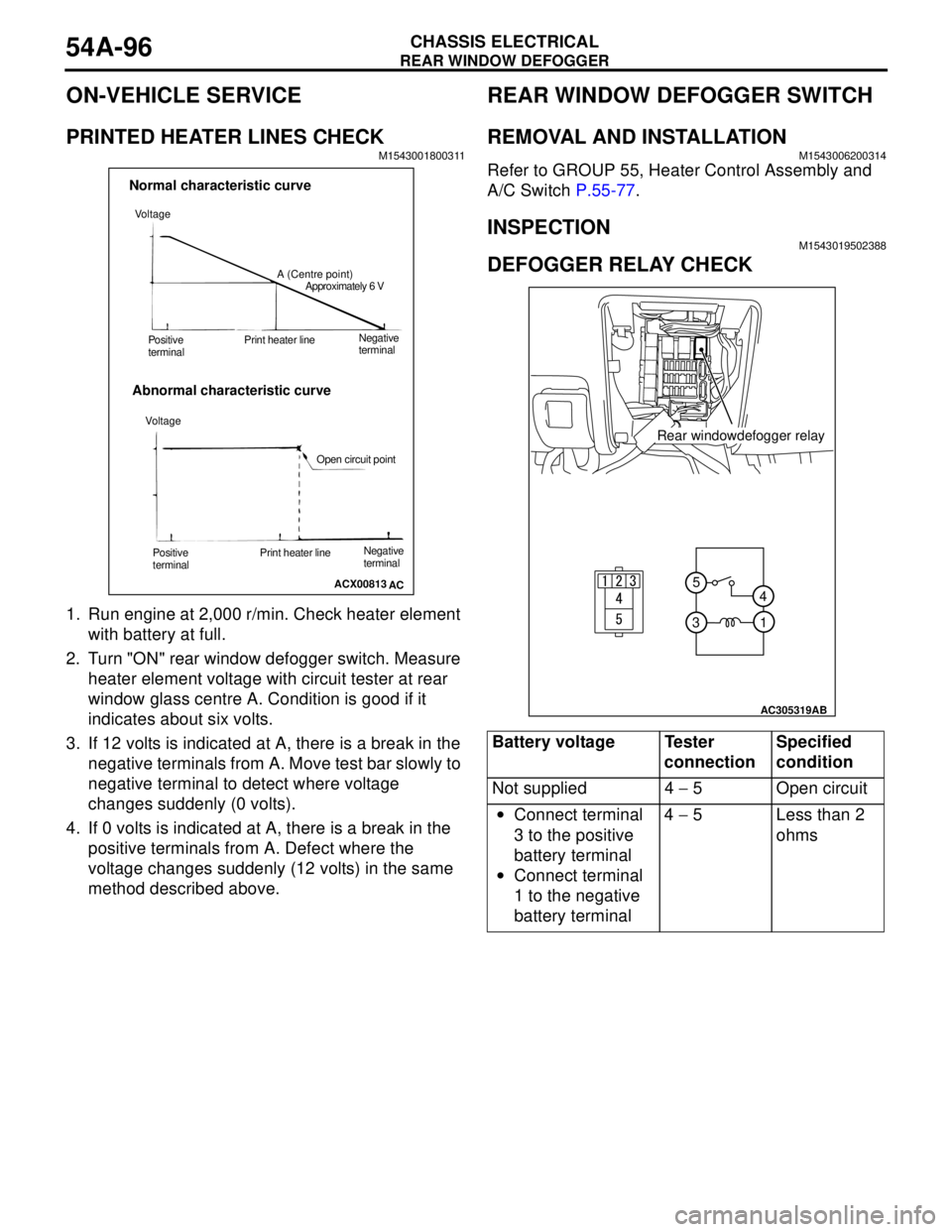
REAR WINDOW DEFOGGER
CHASSIS ELECTRICAL54A-96
ON-VEHICLE SERVICE
PRINTED HEATER LINES CHECKM1543001800311
1. Run engine at 2,000 r/min. Check heater element
with battery at full.
2. Turn "ON" rear window defogger switch. Measure
heater element voltage with circuit tester at rear
window glass centre A. Condition is good if it
indicates about six volts.
3. If 12 volts is indicated at A, there is a break in the
negative terminals from A. Move test bar slowly to
negative terminal to detect where voltage
changes suddenly (0 volts).
4. If 0 volts is indicated at A, there is a break in the
positive terminals from A. Defect where the
voltage changes suddenly (12 volts) in the same
method described above.
REAR WINDOW DEFOGGER SWITCH
REMOVAL AND INSTALLATIONM1543006200314
Refer to GROUP 55, Heater Control Assembly and
A/C Switch P.55-77.
INSPECTIONM1543019502388
DEFOGGER RELAY CHECK
ACX00813
Normal characteristic curve
Abnormal characteristic curve
A (Centre point)
Approximately 6 V
Negative
terminal Print heater line
Positive
terminal
Open circuit point Voltage
AC Voltage
Negative
terminal Print heater line
Positive
terminal
Battery voltage Tester
connectionSpecified
condition
Not supplied 4 − 5 Open circuit
•Connect terminal
3 to the positive
battery terminal
•Connect terminal
1 to the negative
battery terminal4 − 5 Less than 2
ohms
1 5
4
3
AC305319
AB
Rear windowdefogger relay